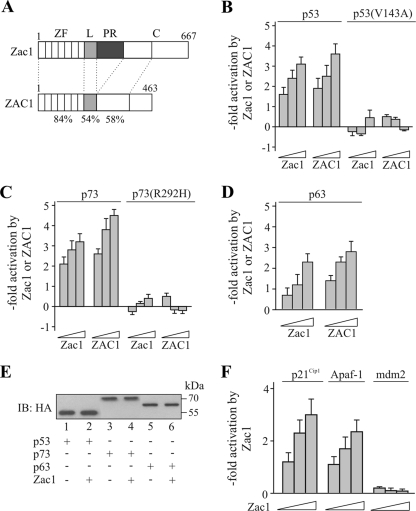FIG. 1.
Zac1 coactivation of p73. (A) Scheme of mouse Zac1 and human ZAC1 proteins, depicting zinc finger (ZF), linker (L), proline-rich (PR), and carboxyl-terminal (C) domains. Amino acid identity (%) between the corresponding domains of mice and humans is indicated. (B to D) Reporter assays. Increasing concentrations of cotransfected Zac1 or ZAC1 enhanced p53-dependent (B), p73-dependent (C), or p63-dependent (D) PG12PYLuc reporter activity in Saos-2 cells. In contrast, Zac1 or ZAC1 did not enhance reporter activity in the presence of DNA-binding-defective p53(V143A) (B) or p73(R292H) (C). (E) IB analysis. Hemagglutinin (HA)-tagged p53 (25 ng) or p73 or p63 (50 ng each) was transfected in the absence (−) or presence (+) of Zac1 (50 ng) into Saos-2 cells. WCE were immunoblotted and tested with an anti-HA antibody. The expression levels of p53, p63, and p73 are unaltered in the presence of Zac1. (F) Reporter assays. Increasing concentrations of cotransfected Zac1 enhanced the p73-dependent promoter activities of p21Cip1 and Apaf-1, whereas the p73-dependent activity of mdm2 was not regulated.

